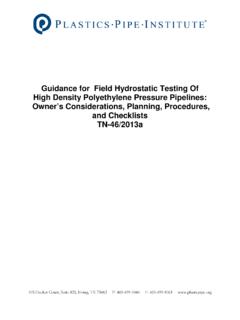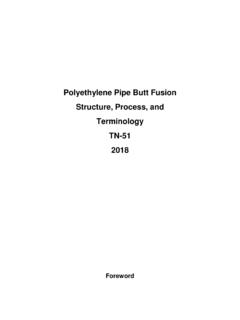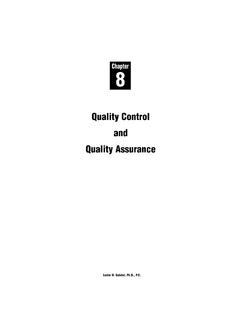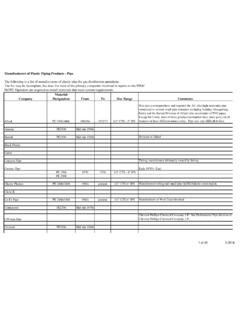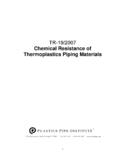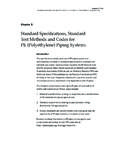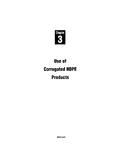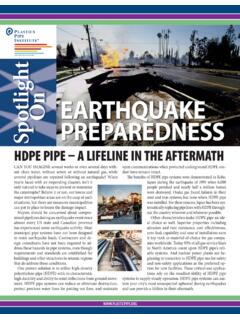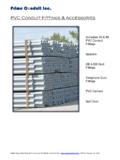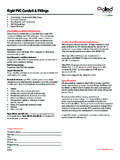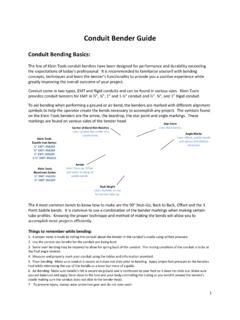Transcription of Guide to Specifying HDPE Conduit - TN-50 - Conduit Division
1 Guide TO Specifying HDPE Conduit TN-50 2019 ii Foreword This technical note was developed and published with the technical help and financial support of the members of the Plastics Pipe Institute (PPI). These members have shown their commitment to developing and improving quality products by assisting standards development organizations in the development of standards, and also by developing design aids and reports to help engineers, code officials, Specifying groups, contractors and users. The purpose of this technical note is to provide general information about the history of the development of high-density polyethylene (HDPE) Conduit and the various standards which apply to these products.
2 The technical note may also be used as a Guide for selecting appropriate standard specifications for users and specifiers. PPI has prepared this technical note as a service to the industry. The information in this report is offered in good faith and believed to be accurate at the time of its preparation, but is offered as is without any express or implied warranty, including WARRANTIES OF MERCHANTABILITY AND FITNESS FOR A PARTICULAR PURPOSE. Additional information may be needed in some areas, especially with regard to unusual or special applications. Consult the manufacturer or material supplier for more detailed information. A list of member manufacturers is available on the PPI website.
3 PPI does not endorse the proprietary products or processes of any manufacturer and assumes no responsibility for compliance with applicable laws and regulations. PPI intends to revise this technical note within 5 years or sooner if required, from the date of its publication, in response to comments and suggestions from users of the document. Please send suggestions of improvements to the address below. Information on other publications can be obtained by contacting PPI directly or visiting our website. The Plastics Pipe Institute, Inc. This Technical Note, TN-50 , was first issued in July 2016 and was revised in October 2016, August 2017 and February 2019.
4 2019 The Plastics Pipe Institute, Guide TO Specifying HDPE Conduit High-density polyethylene (HDPE) Conduit is the preferred material to house and protect electrical power and telecommunications cables within. It offers unmatched corrosion and chemical resistance, is flexible, durable and available in long reel lengths to reduce joints and installation time. HDPE Conduit is available in a variety of sizes, colors, dimensions and lengths. HISTORY OF HDPE Conduit STANDARDS The early driver behind the use of Conduit produced from high-density polyethylene (HDPE) was for deploying and protecting fiber optic (FO) cables placed underground for the telecommunications industry.
5 Tremendous growth occurred for the installation of fiber optic cables during the early to mid-1980s for linking major metropolitan areas. This era saw massive projects where FO cables were being deployed in both aerial and underground installations. These fiber optic cables were typically made and installed in very long lengths up to 30,000 feet (9,145 m), with the goal of using as few splice locations as possible to minimize signal attenuation or decibel (dB) losses in a complete system. Fiber optic c able and the equipment used to send and receive light waves were in the early stages of becoming the technology of choice for streaming huge amounts of voice, video and data over fibers not much thicker than a human hair.
6 However, FO cable needed more protection and different handling procedures as compared to traditional jacketed metallic cables. For buried installations, there was an immediate need for a Conduit system that would offer improved installation efficiencies and cable protection. In metropolitan areas, the smaller diameter FO cables were replacing very large diameter copper cables that filled banks of conduits made up of individual lengths of 3 inch to 6 inch diameter conduits. As these large copper cables were being removed, telephone companies began installing small conduits ranging from 1 to 1 inch, using HDPE water pipe as the Conduit .
7 Multiple 1 or 1 inch HDPE water pipes, commonly termed innerducts , would be pulled into the vacated larger diameter Conduit left behind after the copper cables had been removed. The newly installed HDPE innerducts created multiple pathways that could be used for initial and future fiber optic cable placement, or to use as spares for rapid FO cable deployment in case the initial FO cable got damaged. Multiple 1 inch through 4 inch HDPE innerducts were also being installed in the more rural parts of the network. Much of this work was completed by using new trenchless methods like rail plowing and horizontal directional drilling (HDD), also known as directional boring.
8 This new technique was employed to install pipes, conduits or cables below ground using a surface-mounted drill rig that launches and places a drill string at a shallow angle to the surface, and has tracking and steering capabilities. These procedures are intended to minimize above and below ground surface damage, restoration requirements, and disruption to traffic, with little or no interruption of existing services. 2 HISTORICAL STANDARDS OVERVIEW By the mid-1980s, Fiber Optic cable deployment was booming, and multiple manufacturers of HDPE Conduit were busy keeping up with demand. However, there were no third-party product standards in place specifically for HDPE Conduit , so the industry adopted existing ASTM standards for HDPE pressure pipes, such as those listed below.
9 Many end-user specifications were developed using these HDPE pressure pipe standards. Examples of typical HDPE pressure pipe standards with title and scope: ASTM D3035: Standard Specification for Polyethylene (PE) Plastic Pipe (DR-PR) Based on Controlled Outside Diameter All pipes produced under this specification are intended for use as the distribution and transmission of potable and non-potable water, grey water, reclaimed water, wastewater, force main and gravity municipal sewage, etc. The user should consult the manufacturer to determine whether the material being transported is compatible with polyethylene pipe and will not affect the service life beyond limits acceptable to the user.
10 Extracted, with permission, from ASTM D3035. Copyright ASTM International, 100 Barr Harbor Drive, West Conshohocken, PA 19428. A copy of the complete standard may be purchased from ASTM International, ASTM D2239: Standard Specification for Polyethylene (PE) Plastic Pipe (SIDR-PR) Based on Controlled Inside Diameter This specification covers polyethylene (PE) pipe made in standard inside dimension ratios (SIDR) and pressure rated for water. Included are requirements for PE compounds and requirements and test methods for workmanship, dimensions, elevated temperature sustained pressure, burst pressure, and marking. Extracted, with permission, from ASTM D2239.
